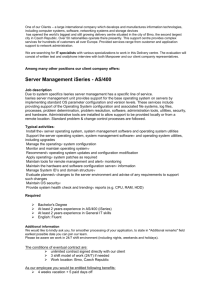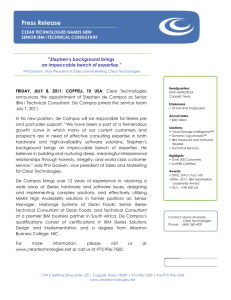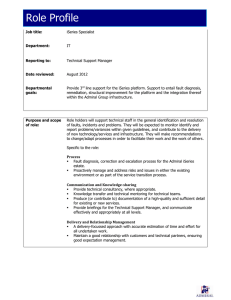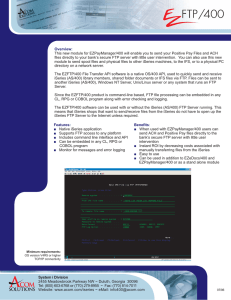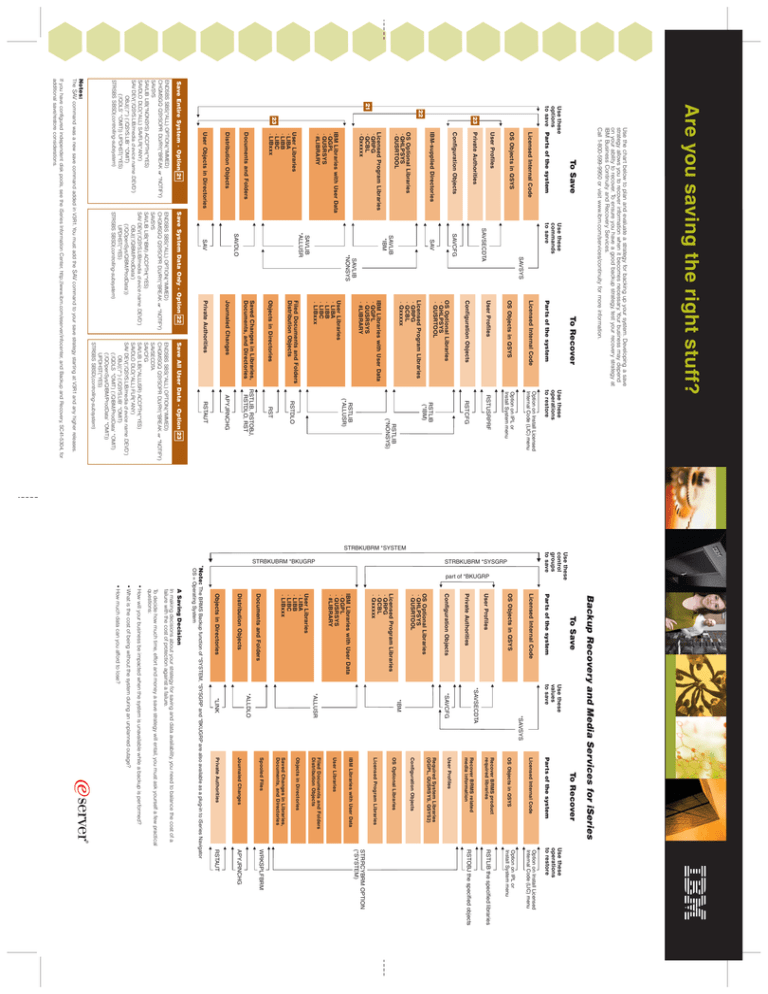
Are you saving the right stuff?
Use these
operations
to restore
Licensed Internal Code
Option on Install Licensed
Internal Code (LIC) menu
RSTLIB
(*ALLUSR)
RSTLIB
(*NONSYS)
RSTLIB
(*IBM)
RSTCFG
RSTUSRPRF
Option on IPL or
Install System menu
IBM Libraries with User Data
QGPL
QUSRSYS
#LIBRARY
Licensed Program Libraries
QRPG
QCBL
Qxxxxx
OS Optional Libraries
QHLPSYS
QUSRTOOL
Configuration Objects
User Profiles
OS Objects in QSYS
Parts of the system
To Recover
Use the chart below to plan and evaluate a strategy for backing up your system. Developing a save
strategy allows you to recover information when it becomes necessary. Your business may depend
on your ability to recover. To ensure you have a good backup strategy, test your recovery strategy at
IBM Business Continuity and Recovery Services.
Call 1-800-599-9950 or visit www.ibm.com/services/continuity for more information.
Use these
commands
to save
SAVSYS
SAVSECDTA
SAVCFG
SAV
SAVLIB
*IBM
SAVLIB
*NONSYS
User Libraries
LIBA
LIBB
LIBC
LIBxxx
RSTDLO
RST
Use these
control
groups
to save
To Recover
Backup Recovery and Media Services for iSeries
To Save
Parts of the system
Use these
operations
to restore
Option on Install Licensed
Internal Code (LIC) menu
Use these
values
to save
Licensed Internal Code
Option on IPL or
Install System menu
Parts of the system
OS Objects in QSYS
RSTLIB the specified libraries
Licensed Internal Code
OS Objects in QSYS
Recover BRMS product
required libraries
*SAVSYS
User Profiles
Private Authorities
Journaled Changes
Spooled Files
RSTAUT
APYJRNCHG
WRKSPLFBRM
Saved Changes in Libraries,
Documents, and Directories
Objects in Directories
Filed Documents and Folders
Distribution Objects
User Libraries
IBM Libraries with User Data
Licensed Program Libraries
OS Optional Libraries
Configuration Objects
Required System Libraries
(QGPL, QUSRSYS, QSYS2)
User Profiles
RSTOBJ the specified objects
*SAVSECDTA
*SAVCFG
*IBM
*ALLUSR
*ALLDLO
*LINK
STRRCYBRM OPTION
(*SYSTEM)
Recover BRMS related
media information
Private Authorities
Configuration Objects
OS Optional Libraries
QHLPSYS
QUSRTOOL
Licensed Program Libraries
QRPG
QCBL
Qxxxxx
IBM Libraries with User Data
QGPL
QUSRSYS
#LIBRARY
User Libraries
LIBA
LIBB
LIBC
LIBxxx
Documents and Folders
Distribution Objects
Objects in Directories
How will your business be impacted when the system is unavailable while a backup is performed?
What is the cost of being without the system during an unplanned outage?
How much data can you afford to lose?
®
To decide how much time, effort and money a save strategy will entail, you must ask yourself a few practical
questions:
In making decisions about your strategy for saving and data availability, you need to balance the cost of a
failure with the cost of protection against a failure.
A Saving Decision
OS = Operating System
*Note: The BRMS Backup function of *SYSTEM, *SYSGRP and *BKUGRP are also available as a plug-in to iSeries Navigator
part of *BKUGRP
To Save
Licensed Internal Code
OS Objects in QSYS
User Profiles
Private Authorities
Configuration Objects
IBM-supplied Directories
OS Optional Libraries
QHLPSYS
QUSRTOOL
Licensed Program Libraries
QRPG
QCBL
Qxxxxx
IBM Libraries with User Data
QGPL
QUSRSYS
#LIBRARY
SAVLIB
*ALLUSR
Objects in Directories
Filed Documents and Folders
Distribution Objects
User Libraries
LIBA
LIBB
LIBC
LIBxxx
STRBKUBRM *SYSGRP
STRBKUBRM *BKUGRP
Use these
options
to save Parts of the system
23
22
21
23
RSTLIB, RSTOBJ,
RSTDLO, RST
APYJRNCHG
Saved Changes in Libraries,
Documents, and Directories
SAVDLO
Journaled Changes
Documents and Folders
Distribution Objects
RSTAUT
Save All User Data - Option 23
Private Authorities
Save System Data Only - Option 22
SAV
Save Entire System - Option 21
ENDSBS SBS(*ALL) OPTION(*IMMED)
CHGMSGQ QSYSOPR DLVRY(*BREAK or *NOTIFY)
SAVSYS
SAVLIB LIB(*IBM) ACCPTH(*YES)
SAV DEV('/QSYS.LIB/media d evice name .DEVD')
OBJ(('/QIBM/ProdData')
('/QOpenSys/QIBM/ProdData'))
UPDHST(*YES)
STRSBS SBSD(controlling-subsystem)
User Objects in Directories
ENDSBS SBS(*ALL) OPTION(*IMMED)
CHGMSGQ QSYSOPR DLVRY(*BREAK or *NOTIFY)
SAVSYS
SAVLIB LIB(*NONSYS) ACCPTH(*YES)
SAVDLO DLO(*ALL) SAVFLR(*ANY)
SAV DEV('/QSYS.LIB/media d evice name .DEVD')
OBJ(('/*') ('/QSYS.LIB' *OMIT)
('/QDLS' *OMIT)) UPDHST(*YES)
STRSBS SBSD(controlling-subsystem)
ENDSBS SBS(*ALL) OPTION(*IMMED)
CHGMSGQ QSYSOPR DLVRY(*BREAK or *NOTIFY)
SAVSECDTA
SAVCFG
SAVLIB LIB(*ALLUSR) ACCPTH(*YES)
SAVDLO DLO(*ALL) FLR(*ANY)
SAV DEV('/QSYS.LIB/media d evice name .DEVD')
OBJ(('/*') ('/QSYS.LIB' *OMIT)
('/QDLS *OMIT) ('/QIBM/ProdData' *OMIT)
('/QOpenSys/QIBM/ProdData' *OMIT))
UPDHST(*YES)
STRSBS SBSD(controlling-subsystem)
Notes:
The SAV command was a new save command added in V3R1. You must add the SAV command to your save strategy starting at V3R1 and any higher releases.
If you have configured independent disk pools, see the iSeries Information Center, http://www.ibm.com/eserver/infocenter, and Backup and Recovery, SC41-5304, for
additional save/restore considerations.
STRBKUBRM *SYSTEM
G325-6328-04
Other company, product, and service names
may be trademarks or service marks of others.
Are you saving the right stuff?
IBM, the IBM logo, e (logo) server, eServer, and
Tivoli are trademarks of the IBM Corporation in
the United States or other countries or both.
References in this publication to IBM products
or services do not imply that IBM intends to
make them available in every country.
Internet URL:
http://www.ibm.com/eserver/iseries
Fax comments to:
1-800-937-3430 (U.S. or Canada)
1-507-253-5192 (outside the U.S. or Canada)
Mail comments to:
IBM Corporation
Attention Department DDR
3605 Highway 52 North
Rochester, MN U.S.A. 55901-7829
Printed in the United States of America
08-05
All Rights Reserved
International Business Machines Corporation
1996, 2005
®
The Basics
Availability Options
A combination of hardware and software that stores, catalogs, and loads
tapes automatically. See the Storage solutions topic in the iSeries Information
Center for more information.
Software functions that support saving information from your system and
restoring it to your system or to another iSeries business computing system.
See Backup and Recovery, SC41-5304, and the Back up your server topic in the
iSeries Information Center for more information.
Automated Tape Library Systems
Save and Restore Operations
Capacity on Demand
The capability that allows you to dynamically activate one or more processors on
your server as your business peaks dictate. See the Capacity on Demand topic in
the iSeries Information Center for more information.
Clustered Systems
Tivoli Storage Manager for iSeries
Storage Devices
Different types of hardware to meet a variety of requirements for performance,
capacity, and cost. For more information about storage devices that are available
to attach to your system, call 1-800-IBM-CALL (1-800-426-2255) and see the
Storage Solutions topic in the iSeries Information Center.
Availability and Recovery
Availability of a business system has become more critical with every application
and user that is added to the system. You must ensure that your entire system is
backed up and protected, and that your recovery process is known and tested
prior to any failure. See the Availability topic in the iSeries Information Center for
more information.
Additional Hardware and Software
Hardware Management Console
Journal Management
Hierarchical Storage Management (HSM)
A cluster is a collection or group of one or more systems that work together as a
single system. Clustered systems let you effeciently group your systems together to
set up an environment that approaches 100 percent availability. See the Clustering
topic in the iSeries Information Center for more information.
A licensed program to protect data on your workstations and local area networks.
Tivoli Storage Manager can automate backing up and archiving, including TSM
Client backup. It provides a disaster recovery solution for workstations. See
http://www.tivoli.com/products/index/storage_mgr, for more information.
System-Managed Access-Path Protection (SMAPP)
A licensed program to index, archive, and retrieve large volumes of historical data
onto disk, optical volumes, or tape. See the IBM Content Manager OnDemand for
iSeries System Administration, SC41-5325, for more information.
A software recovery and system integrity function that supports the logging of
changes to database files and other events that occur on the system. You can use
the journal entries to recover. Journaling is a part of Journal Management, which
can be used for an audit trail and for application testing. See the Journal
Management topic in the iSeries Information Center for more information.
Hierarchical storage management provides automatic and transparent management
of data across a storage hierarchy. The hierarchy may consist of high performance
disks, compressed disks, or tape, and is based on user-defined policies. For more
information, refer to Hierarchical Storage Management, SC41-5351.
IBM Content Manager OnDemand for iSeries
A software availability function that reduces the time that it takes to perform an IPL
after your system ends abnormally. See the Journal Management topic in the
iSeries Information Center for more information.
Disk Pools
Services and Training
A group that provides consulting services, tools, and education to support
availability management and recovery readiness on the iSeries business
computing system. For more information, call 1-800-IBM-4YOU (1-800-426-4968).
A licensed program that both simplifies and automates your backup and recovery
operations as well as manages and protects your media inventory. BRMS keeps
track of what, when, and where you backed up your data and seamlessly
integrates your automated tape library system for your business. BRMS networking
feature allows for a networked enterprise to have media management across
systems. BRMS advanced feature allows for the total HSM solution providing rules
and policies for migrating data to and from compressed DASD, as well as
archiving and dynamically retrieving to and from your automated tape library
system. See Backup Recovery and Media Services for iSeries, SC41-5345, for
more information and the Backup Recovery and Media Services topic in the
iSeries Information Center.
iSeries Availability Support Center
Backup Recovery and Media Services for iSeries
A group of consultants to help you design, set up, and manage a recovery
strategy. A center with a wide range of iSeries hardware for testing recovery and
performing a recovery. For more information, call 1-800-599-9950.
Manage eServer servers, logical partitions, and Capacity on Demand with the
Hardware Management Console (HMC). The HMC communicates with systems
using service applications to detect, consolidate, and send information to IBM for
analysis. If you are using the HMC, you should back up critical console data. See
the Hardware Management Console topic in the eServer Hardware Information
Center, www.ibm.com/servers/library/infocenter, for more information.
A software recovery function that supports the division of your disk storage into
logically separate areas, according to your availability and recovery needs. You can
use independent disk pools and make them available to the system when you
need to access the data. You can also geographically mirror independent disk
pools. See the Disk Management topic in the iSeries Information Center for more
information.
IBM Business Continuity and Recovery Services
Device Parity Protection
A hardware availability function that stores redundant bits of data on disk units so
that the system can recover from one or two disk failures without requiring you to
restore from a backup. In many cases, the system remains operational while a disk
unit is being repaired or replaced. See the Disk Management topic in the iSeries
Information Center for more information.
Recovery Readiness Exam
A service offered by the iSeries Availability Support Center to help you to
determine the most cost-effective way to reduce the frequency and duration of
unplanned outages.
Mirrored Protection
A software availability function that uses redundant hardware to protect from
failures associated with the disk subsystems. With mirrored protection, data is
written twice. If a disk failure occurs, the second copy of the data is used. In many
cases, the system remains operational while disk components are repaired or
replaced. See the Disk Management topic in the iSeries Information Center for
more information.
Data Migration Service Offerings
Services offered by the iSeries Availability Support Center to move data from your
current configuration to new disks or to a new system.
Dual Systems
An availability approach that provides redundancy of all critical system
components and data. Data is kept up to date on a backup system. Users can be
switched to the backup system if the primary system becomes unavailable. Several
software providers have developed programs to support this approach.
Uninterruptible Power Supply
iSeries Information Center
www.ibm.com/eserver/iseries/infocenter
Combined hardware and software capabilities that keep the system running for a
short period after a power loss and stop the system normally. This reduces the
time to perform an IPL when the power returns. See the Planning topic in the
eServer Hardware Information Center for more information.
eServer Information Center
www.ibm.com/servers/library/infocenter
OptiConnect
A type of support that can connect multiple iSeries business computing systems
by using a fiber optic cable. You can use OptiConnect with ObjectConnect to
move objects between systems quickly and efficiently. See the Networking topic in
the iSeries Information Center for more information.
ObjectConnect
A set of CL commands for moving objects between iSeries systems simply and
efficiently. ObjectConnect is included with the operating system. You install it on the
Install Licensed Program display. See Backup and Recovery, SC41-5304, for more
information.
The iSeries Family of Products

